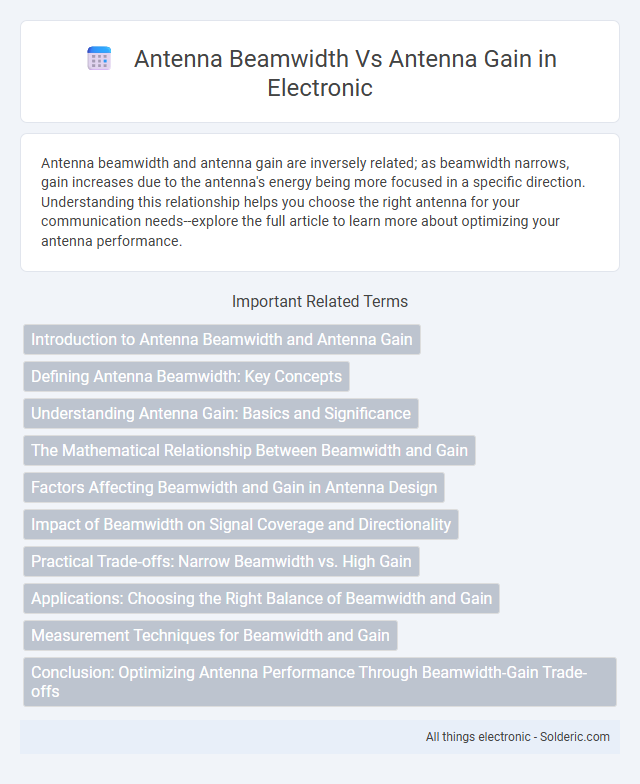Antenna beamwidth and antenna gain are inversely related; as beamwidth narrows, gain increases due to the antenna's energy being more focused in a specific direction. Understanding this relationship helps you choose the right antenna for your communication needs--explore the full article to learn more about optimizing your antenna performance.
Comparison Table
| Parameter | Antenna Beamwidth | Antenna Gain |
|---|---|---|
| Definition | The angular width where the antenna radiates at half its maximum power (typically measured in degrees). | The measure of how effectively an antenna directs energy in a specific direction (measured in dBi or dBd). |
| Unit | Degrees (deg) | Decibels relative to isotropic (dBi) or dipole (dBd) |
| Relation | Inverse relation to antenna gain: narrower beamwidth means higher gain. | Directly related to beam focusing; higher gain means narrower beamwidth. |
| Typical Range | 10deg to 120deg for most antennas | 0 dBi (omnidirectional) up to 30+ dBi (high directional) |
| Function | Determines antenna coverage area and directionality | Indicates signal strength and transmission/reception efficiency |
| Application Impact | Wide beamwidth preferred for broad coverage; narrow for point-to-point links | High gain improves long-distance communication and signal quality |
Introduction to Antenna Beamwidth and Antenna Gain
Antenna beamwidth measures the angular width of the main lobe of an antenna's radiation pattern, typically defined between the half-power (-3 dB) points. Antenna gain quantifies how effectively the antenna directs radio energy in a particular direction compared to an isotropic radiator, expressed in decibels (dBi). Understanding the balance between beamwidth and gain is crucial for optimizing your antenna's performance in targeting specific coverage areas while maximizing signal strength.
Defining Antenna Beamwidth: Key Concepts
Antenna beamwidth is defined as the angular separation where the radiated power drops to half its maximum value, typically measured between the half-power (-3 dB) points on the main lobe. Beamwidth directly influences antenna gain; narrower beamwidths concentrate energy more effectively, resulting in higher gain by focusing the radiation pattern. Understanding this relationship is crucial for designing antennas optimized for specific directional or coverage requirements in applications such as radar, wireless communications, and satellite systems.
Understanding Antenna Gain: Basics and Significance
Antenna gain measures the ability of an antenna to focus energy in a specific direction, directly impacting signal strength and quality. Reduced beamwidth implies a narrower radiation pattern, concentrating energy for higher gain, which enhances your communication range and reception. Understanding this trade-off between beamwidth and gain is crucial for optimizing antenna performance in various wireless applications.
The Mathematical Relationship Between Beamwidth and Gain
The mathematical relationship between antenna beamwidth and gain is fundamentally inverse, where gain (G) can be approximated by the formula G 4p / O, with O representing the beam solid angle derived from the beamwidth in radians. Narrower beamwidth results in smaller beam solid angle, leading to higher directivity and gain, as the radiated power is concentrated over a smaller angular region. This principle is crucial in antenna design, optimizing signal strength and coverage by balancing beamwidth and gain based on application requirements.
Factors Affecting Beamwidth and Gain in Antenna Design
Antenna beamwidth and gain are influenced by factors such as antenna size, shape, and operating frequency, where larger apertures typically yield narrower beamwidths and higher gain. The antenna element spacing and array configuration also play critical roles, as tighter spacing can enhance directivity but may introduce mutual coupling effects that affect overall gain. Material properties and feed mechanisms impact efficiency, further modifying the effective beamwidth and realized gain in practical antenna designs.
Impact of Beamwidth on Signal Coverage and Directionality
Antenna beamwidth directly influences signal coverage and directionality by determining the angular span over which the antenna radiates energy. Narrow beamwidth antennas concentrate energy into a smaller area, resulting in higher antenna gain and improved signal strength in the targeted direction. Conversely, wider beamwidth antennas offer broader coverage with reduced gain, which is advantageous for applications requiring extensive area coverage but lower signal intensity.
Practical Trade-offs: Narrow Beamwidth vs. High Gain
Narrow beamwidth antennas offer high gain by concentrating energy into a smaller angular region, enhancing signal strength and range for point-to-point communication. However, this focused beam reduces coverage area and requires precise alignment, making it less practical for mobile or wide-area applications. Conversely, wider beamwidth antennas provide broader coverage but at the cost of lower gain, which decreases signal intensity over distance.
Applications: Choosing the Right Balance of Beamwidth and Gain
Selecting the appropriate antenna beamwidth and gain depends on the specific application requirements, such as coverage area and signal strength. Narrow beamwidth antennas provide high gain and precise targeting, ideal for long-distance point-to-point communication or radar systems. Wider beamwidth antennas offer broader coverage with lower gain, making them suitable for applications like cellular base stations and Wi-Fi networks where area coverage is prioritized.
Measurement Techniques for Beamwidth and Gain
Accurate measurement of antenna beamwidth and gain relies on techniques like the far-field method, where the antenna is tested at a distance several wavelengths away from the source to capture its radiation pattern. Using a rotational setup, the antenna is rotated to record signal strength across angles, enabling precise beamwidth calculation at the half-power (-3 dB) points. Your antenna's gain is quantified by comparing its measured power density to that of an isotropic reference antenna, often utilizing calibrated equipment such as network analyzers and anechoic chambers to minimize external interference.
Conclusion: Optimizing Antenna Performance Through Beamwidth-Gain Trade-offs
Optimizing antenna performance requires balancing beamwidth and antenna gain to achieve desired coverage and signal strength. Narrow beamwidth antennas offer higher gain and focused energy, enhancing long-distance communication and reducing interference, while wider beamwidth antennas provide broader coverage with lower gain. Selecting the appropriate beamwidth-gain trade-off depends on specific application requirements, environmental factors, and the need for either directional precision or area coverage.
antenna beamwidth vs antenna gain Infographic

 solderic.com
solderic.com